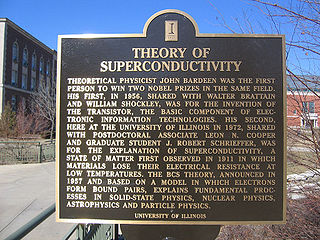
BCS theory or Bardeen–Cooper–Schrieffer theory is the first microscopic theory of superconductivity since Heike Kamerlingh Onnes's 1911 discovery. The theory describes superconductivity as a microscopic effect caused by a condensation of Cooper pairs. The theory is also used in nuclear physics to describe the pairing interaction between nucleons in an atomic nucleus.
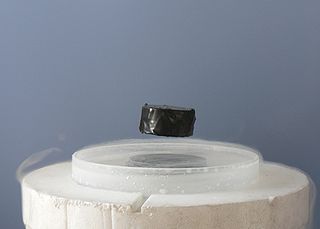
Superconductivity is a set of physical properties observed in certain materials where electrical resistance vanishes and magnetic fields are expelled from the material. Any material exhibiting these properties is a superconductor. Unlike an ordinary metallic conductor, whose resistance decreases gradually as its temperature is lowered, even down to near absolute zero, a superconductor has a characteristic critical temperature below which the resistance drops abruptly to zero. An electric current through a loop of superconducting wire can persist indefinitely with no power source.
Unconventional superconductors are materials that display superconductivity which does not conform to conventional BCS theory or its extensions.
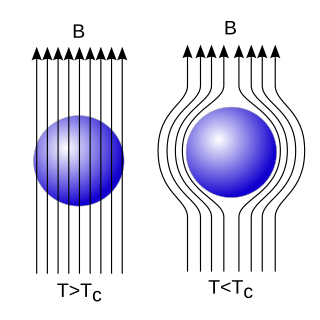
The Meissner effect is the expulsion of a magnetic field from a superconductor during its transition to the superconducting state when it is cooled below the critical temperature. This expulsion will repel a nearby magnet.

High-temperature superconductors are defined as materials with critical temperature above 77 K, the boiling point of liquid nitrogen. They are only "high-temperature" relative to previously known superconductors, which function at even colder temperatures, close to absolute zero. The "high temperatures" are still far below ambient, and therefore require cooling. The first break through of high-temperature superconductor was discovered in 1986 by IBM researchers Georg Bednorz and K. Alex Müller. Although the critical temperature is around 35.1 K, this new type of superconductor was readily modified by Ching-Wu Chu to make the first high-temperature superconductor with critical temperature 93 K. Bednorz and Müller were awarded the Nobel Prize in Physics in 1987 "for their important break-through in the discovery of superconductivity in ceramic materials". Most high-Tc materials are type-II superconductors.
In condensed matter physics, a Cooper pair or BCS pair is a pair of electrons bound together at low temperatures in a certain manner first described in 1956 by American physicist Leon Cooper.
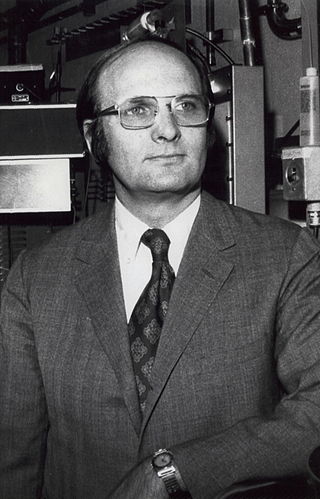
John Robert Schrieffer was an American physicist who, with John Bardeen and Leon Cooper, was a recipient of the 1972 Nobel Prize in Physics for developing the BCS theory, the first successful quantum theory of superconductivity.

A fermionic condensate is a superfluid phase formed by fermionic particles at low temperatures. It is closely related to the Bose–Einstein condensate, a superfluid phase formed by bosonic atoms under similar conditions. The earliest recognized fermionic condensate described the state of electrons in a superconductor; the physics of other examples including recent work with fermionic atoms is analogous. The first atomic fermionic condensate was created by a team led by Deborah S. Jin using potassium-40 atoms at the University of Colorado Boulder in 2003.
The Little–Parks effect was discovered in 1962 by William A. Little and Ronald D. Parks in experiments with empty and thin-walled superconducting cylinders subjected to a parallel magnetic field. It was one of the first experiments to indicate the importance of Cooper-pairing principle in BCS theory.
Color superconductivity is a phenomenon where matter carries color charge without loss, on analogy to the way conventional superconductors can carry electric charge without loss. Color superconductivity is predicted to occur in quark matter if the baryon density is sufficiently high (i.e., well above the density and energies of an atomic nucleus) and the temperature is not too high (well below 1012 kelvins). Color superconducting phases are to be contrasted with the normal phase of quark matter, which is just a weakly interacting Fermi liquid of quarks.

In condensed matter physics, a pseudogap describes a state where the Fermi surface of a material possesses a partial energy gap, for example, a band structure state where the Fermi surface is gapped only at certain points. The term pseudogap was coined by Nevill Mott in 1968 to indicate a minimum in the density of states at the Fermi level, N(EF), resulting from Coulomb repulsion between electrons in the same atom, a band gap in a disordered material or a combination of these. In the modern context pseudogap is a term from the field of high-temperature superconductivity which refers to an energy range (normally near the Fermi level) which has very few states associated with it. This is very similar to a true 'gap', which is an energy range that contains no allowed states. Such gaps open up, for example, when electrons interact with the lattice. The pseudogap phenomenon is observed in a region of the phase diagram generic to cuprate high-temperature superconductors, existing in underdoped specimens at temperatures above the superconducting transition temperature.
In superconductivity, the superconducting coherence length, usually denoted as , is the characteristic exponent of the variations of the density of superconducting component.
In solid-state physics, an energy gap or band gap is an energy range in a solid where no electron states exist, i.e. an energy range where the density of states vanishes.
A charge density wave (CDW) is an ordered quantum fluid of electrons in a linear chain compound or layered crystal. The electrons within a CDW form a standing wave pattern and sometimes collectively carry an electric current. The electrons in such a CDW, like those in a superconductor, can flow through a linear chain compound en masse, in a highly correlated fashion. Unlike a superconductor, however, the electric CDW current often flows in a jerky fashion, much like water dripping from a faucet due to its electrostatic properties. In a CDW, the combined effects of pinning and electrostatic interactions likely play critical roles in the CDW current's jerky behavior, as discussed in sections 4 & 5 below.
Cuprate superconductors are a family of high-temperature superconducting materials made of layers of copper oxides (CuO2) alternating with layers of other metal oxides, which act as charge reservoirs. At ambient pressure, cuprate superconductors are the highest temperature superconductors known. However, the mechanism by which superconductivity occurs is still not understood.
A Peierls transition or Peierls distortion is a distortion of the periodic lattice of a one-dimensional crystal. Atomic positions oscillate, so that the perfect order of the 1-D crystal is broken.
The Mattis–Bardeen theory is a theory that describes the electrodynamic properties of superconductivity. It is commonly applied in the research field of optical spectroscopy on superconductors.
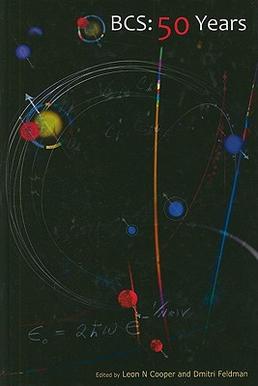
BCS: 50 Years is a review volume edited by Leon Cooper, a 1972 Nobel Laureate in Physics, and Dmitri Feldman of Brown University, first published in 2010.
Several hundred metals, compounds, alloys and ceramics possess the property of superconductivity at low temperatures. The SU(2) color quark matter adjoins the list of superconducting systems. Although it is a mathematical abstraction, its properties are believed to be closely related to the SU(3) color quark matter, which exists in nature when ordinary matter is compressed at supranuclear densities above ~ 0.5 1039 nucleon/cm3.
Kazumi Maki was a Japanese theoretical physicist, known for his research in "superconductivity, superfluid ³He, and quasi‑one‑dimensional (1D) materials."







